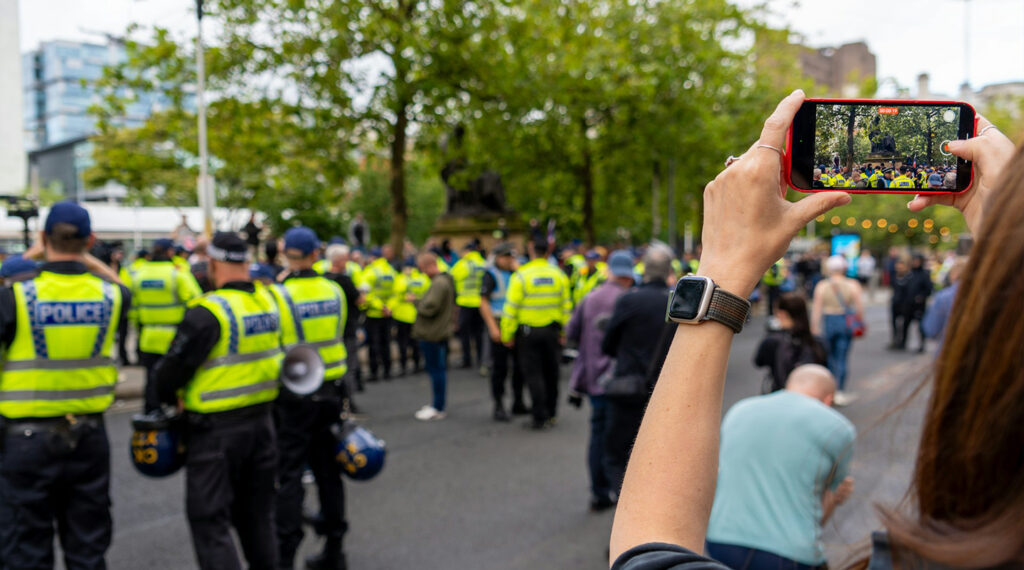Lessons from Britain’s riots for resilience and cohesion

Britain saw its worst outbreak of public disorder for over a decade this summer. The killing of three young girls in Southport saw an outpouring of public grief. There was an effort to target asylum seekers and Muslims as a violent retaliation against groups with no connection to the shocking crime. The violence spread at pace – mostly as a series of one-off flashpoints in over thirty locations. Fewer than five thousand people were involved, though with wider participation online. Around fifteen thousand people took part in widely celebrated counter-protests, mobilised in response to online threats of widespread vigilante violence across the UK.
The UK government’s initial focus was to be visibly tough on violence, disorder and hatred. Rapid and visible prosecutions played a role in restoring order. A new paper, After the Riots co-published by British Future, the Belong Network and the Together Coalition recommends how the UK government could now go on to address the causes of disorder by putting in place the missing foundations for a strategy for community cohesion and tackling prejudice in the UK.
Though Europe’s increasingly diverse democracies have distinct histories, experiences and discourses about migration and integration, many are grappling with shared or at least parallel challenges about identity, change and populist responses today.
What are the insights after the British riots for political and civic voices seeking to broaden confidence in a shared future in politically polarised times?
1. Think strategically: different audiences matter for different objectives
Most people strongly opposed the violence and disorder. But 85% disapproval of violence leaves 7% of people willing to say they supported it – including 2% who were strongly supportive. That is a large enough toxic minority to not just give moral oxygen to the disorder – but to spread fear well beyond those places where mayhem broke out.
Democratic governments need a narrative and message to elevate the perspective of the 75% that can entrench and extend norms against violence and prejudice – and broaden confidence that working together for inclusion, integration and against extremism can be a shared endeavour.
That needs to be combined with a plan of action for the dangers presented by the offside minority too. That depends on unpacking and defusing the causes of fear, hatred and prejudice that underpin racialised grievances.
Different audiences matter for different challenges.
Victims of prejudice need solidarity and support to report and prosecute hate crimes. Those with the most supportive attitudes can be mobilised for stronger policies to tackle hatred.
Policing, prosecution and deradicalisation efforts are important for those who act on their prejudices. More pressure on social media companies to contain the national security risks generated when criminal material which incites violence and stirs up hatred can spread with impunity.
Yet misinformation is created, shared and believed due to the latent prejudices and threat perceptions that it seeks to trigger. So the core of a strategy to reduce prejudice needs effective ways to reach into those sections of mainstream society more sceptical about asylum seekers and Muslims than other minority groups in ways that can challenge and defuse casual prejudices that stereotype these out groups.
2. Be clear about how to differentiate “legitimate concerns” and be clear about what is illegitimate too.
There was a contested debate about the role of migration underpinning the disorder. Did violence bubble up because politicians were too afraid to debate immigration, as right-of-centre commentators claimed, or were they stoked up by the incendiary language of those who talk about little else?
In talking about legitimate concerns, it is essential to be clear about what is illegitimate too. The violence and disorder of the summer of 2024 was an orgy of illegitimate concerns. Properly understood, legitimate concerns are a two-way street. There are ‘legitimate concerns’ about how a democracy handles the pressures and gains of migration and social change – and also about keeping racism, prejudice and violence out of our democratic debate. A legitimate debate about migration and integration would address both sets of concerns. In a democratic debate, there are different views about immigration policy and politics. So ‘legitimate concerns’ are about a right to have your voice heard, not a right to get everything you want.
3. Extending anti-prejudice norms to the newest arrivals
British-born minorities – like myself – would often pointed out to racists – in the school playground decades ago, or once again when attacked by online bigots today – that we too were born in this country. In doing so we were, in a sense, deploying a form of nativist privilege that is not as easily available to recent arrivals with precarious status. It can be more difficult to extend anti-prejudice norms to the most recent arrivals with precarious status. The polarised political debate about asylum seekers has included language about “invaders” and “men of fighting age” that dehumanises asylum seekers and gives moral oxygen to those seeking to socialise people towards violence. A breakdown of communication between national and local government over the accommodation of asylum seekers meant there have been too few efforts to communicate with local councils or communities, or to promote constructive contact between local people and asylum seekers.
4. Extending meaningful contact by generation and geography over time
In the 2020s, every school-child should experience significant, meaningful contact across ethnic and faith lines – including with Jews, Muslims and other backgrounds. This may happen organically in schools in diverse city centres – and, over time, in the suburbs too. That is harder to emulate in towns twenty miles down the road, or out on the coast. Every school can consider its proactive contribution – such as school linking projects across a region – to ensure that we all have some early experience of those we share a society with.
5. Use national and local moments to communicate with those least likely to have real world contact with out-groups
Those in the least diverse areas form their perceptions of “out groups” through news events and media images. National and local traditions – such as the role of Muslims and other ethnic and faith minorities in military service during Britain’s traditions of Remembrance – offer important ways to project the value of extending contact, and to make a practical difference by showing more of it taking place, in ways that can reach those least likely to have contact.
Authors

